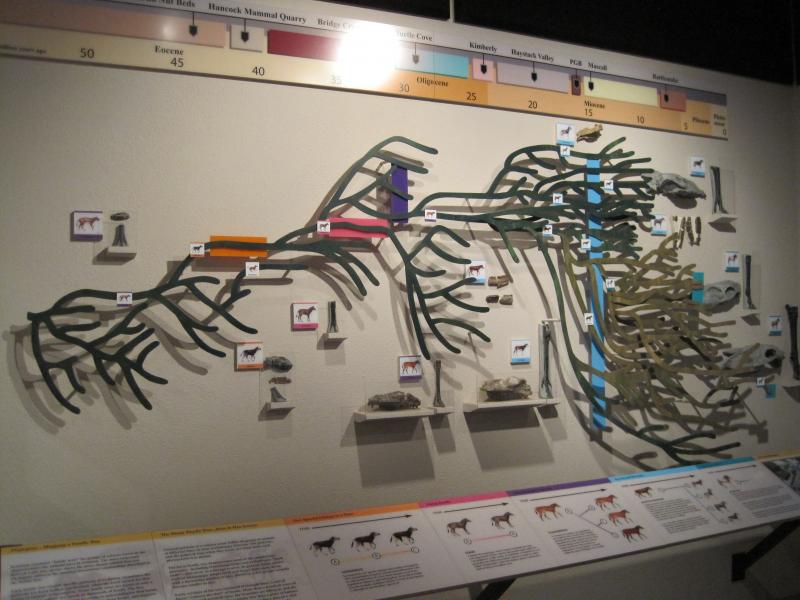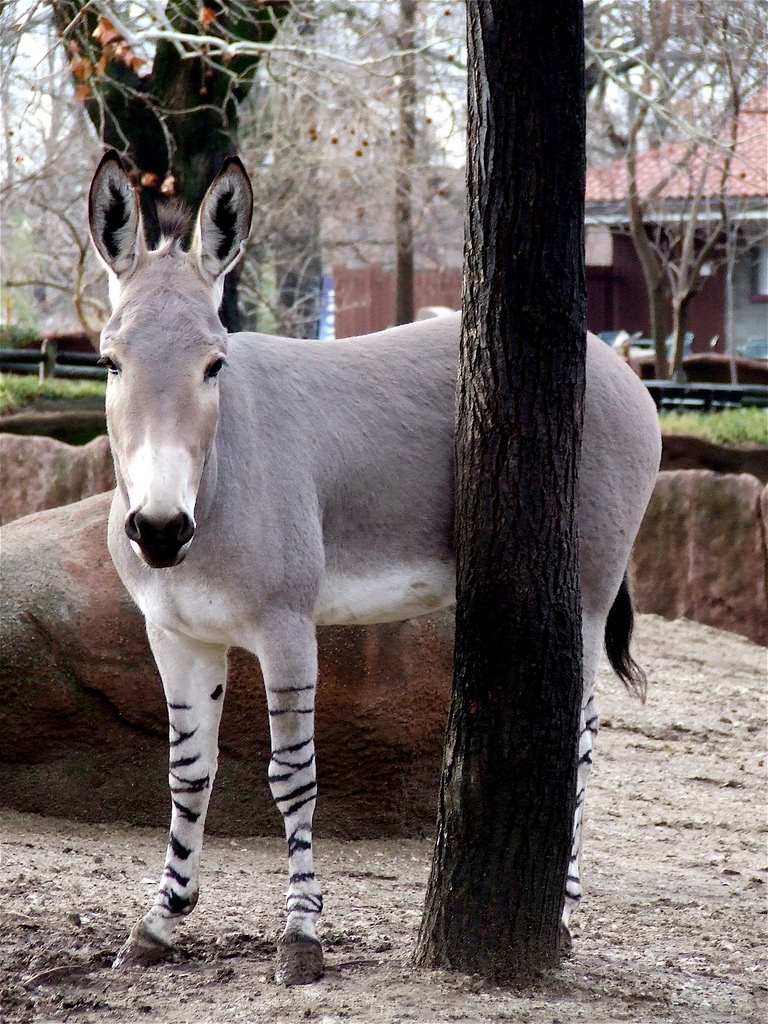 In Part 1 of this blog, I explained the origin of a modern textbook taboo: diagrams that suggest a unidirectional and linear evolution of horses. These justly criticized illustrations give the impression that through a series of progressive changes, horses evolved to their current, perfected form. Not at all true. Rather modern horses are just one twig within the big bushy and multidirectional evolutionary history of the group that includes modern horses and their ancient horsey relatives. There is nothing particularly special about living horses, save that they are the only surviving members of a once very diverse group.
In Part 1 of this blog, I explained the origin of a modern textbook taboo: diagrams that suggest a unidirectional and linear evolution of horses. These justly criticized illustrations give the impression that through a series of progressive changes, horses evolved to their current, perfected form. Not at all true. Rather modern horses are just one twig within the big bushy and multidirectional evolutionary history of the group that includes modern horses and their ancient horsey relatives. There is nothing particularly special about living horses, save that they are the only surviving members of a once very diverse group.

But, in my last post, I suggested that with a few tweaks, diagrams showing the evolutionary trends along the lineage of modern horses should be fairly non-controversial. Why? Because when you limit yourself to just the lineage that leads to modern horses, the trends, which include overall increases in size and tooth-crown height and an overall decrease in number of toes, are valid. It’s misleading to present these trends in a straight line on a diagram since the lineage zigs and zags (A did not morph into B; rather A split into B and C). But as long as the diagrams and text are careful not to mistakenly give the impression that modern horses are the pinnacle of evolution, we should be able to talk about the patterns that Cope and Huxley documented all those years ago. (Here is a nice example of such a diagram—not linear! But the trends along the lineage are clear though it does not give the impression that the trend is characteristic of all lineages. Also, see this paper for an excellent summary of how these trends are depicted in musems across the country. Short version? Not all that well.)
I think part of the problem today is an rooted in terminology. If more people were familiar and happy with the terms equids and equines, the world would be a happier place, or at least the evolution education segment of it would be. Quick taxonomy vocab lesson: Equids are members of the family Equidae that include equines and their extinct ancestors back to the most recent common ancestor with their sister group, which includes rhinoceroses and tapirs. Equines are members of the only surviving Equidae genus, Equus, and include living zebras, donkeys, and horses.
 Equipped with these terms, we can say, “the evolution of equids is a bush with no discernable trends. The evolution of equines, which is one branch of that bush, does show some general trends toward increased size, higher-crowned teeth, and fewer toes.” But maybe you’re not excited about introducing so many archaic-sound terms. If so, you can substitute in “living horses and their extinct relatives” for equids and “living horses” for equines—just be sure that your students understand that zebras and donkeys are horses!
Equipped with these terms, we can say, “the evolution of equids is a bush with no discernable trends. The evolution of equines, which is one branch of that bush, does show some general trends toward increased size, higher-crowned teeth, and fewer toes.” But maybe you’re not excited about introducing so many archaic-sound terms. If so, you can substitute in “living horses and their extinct relatives” for equids and “living horses” for equines—just be sure that your students understand that zebras and donkeys are horses!
All of this serves to highlight what was really happening all along: a ladder was being imposed on a bush. Cope and Huxley had point A (Hyracotherium) and they had point B (modern equines) and they just drew a line between them. It’s not that it’s wrong to draw such a line—but it isn’t telling the whole story. My colleague and friend Anna Thanukos over at UCMP offers this excellent analogy: If you climb a tree and happen to be holding on to a branch that points east, is it accurate to say the tree is growing east? No. The tree is growing in many different directions, but the branch that  you are most intimately familiar with happens to have sprouted in this direction and kept going that way. That’s how it is with the evolution of horses. The branch you’re sitting on represents modern horses—they did indeed get bigger, and lost toes, and got higher crowned teeth over the course of their evolution. But there are lots of other branches on the tree that represent groups that did something different over the course of theirs.
you are most intimately familiar with happens to have sprouted in this direction and kept going that way. That’s how it is with the evolution of horses. The branch you’re sitting on represents modern horses—they did indeed get bigger, and lost toes, and got higher crowned teeth over the course of their evolution. But there are lots of other branches on the tree that represent groups that did something different over the course of theirs.
If there had been huge diversity among living equines, Huxley and Cope probably wouldn’t have succumbed to the temptation to generalization and extrapolation. It was only because they had such a discrete endpoint that their mischaracterization of horse evolution was possible. As Gould writes,
This is life’s little joke. By imposing the model of the ladder upon the reality of bushes, we have guaranteed that our classic examples of evolutionary progress can only apply to unsuccessful lineages on the very brink of extermination—for we can linearize a bush only if it maintains but one surviving twig that we can falsely place at the summit of a ladder.
In other words, this whole tale was made possible because we had such a small group of surviving organisms to erroneously hold up as the apogee of the group’s evolution. And, as Gould again points out, this also explains why it’s so easy for us to see humans as the culmination of evolution—there aren’t many other hominins around to help us feel a bit more humble.

